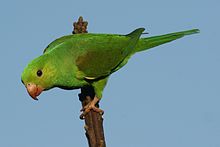Psittacidae
The psittacines (Psittacidae) are a family of psittaciformes birds commonly called parrots or parrots, which includes to macaws, parrots and related forms of America and Africa. It is classified within the Psittacoidea superfamily along with the other two families of typical parrots: Psittrichasiidae and Psittaculidae.
Features
They have a characteristically curved beak, a slightly mobile upper jaw that butts into the skull, and a generally upright posture. They live as a rule in warm and wooded areas, they are good fliers and dexterous climbers of branches and trees thanks to their zygodactyl prehensile claws. They also have a large cranial capacity, being one of the most intelligent groups of birds.
The life of parrots reaches, depending on the species, from five to seventy-five years.
The oldest parrot on record was Cookie, a cockatoo, who was the Guinness World Record holder for the longest-lived parrot in history. He died in 2016 at the age of eighty-three and lived most of his life at Brookfield Zoo after being shipped from an Australian zoo at about a year of age.
Intelligence
Many beautiful species of parrots can imitate the human voice and other sounds, despite not having vocal cords. Researcher Irene Pepperberg has published work on the learning ability of an African gray parrot named Alex, who was trained to use words in order to identify objects, describe them, count them, and even answer complex questions, such as "how many squares?" Are there reds? (with an accuracy of 80%).
Distribution
Psittacines are distributed mainly throughout the Americas. Currently only in the Neotropics, although the extinct Carolina Parakeet lived in the United States, where they inhabit many different wooded habitats, from humid tropical jungles to savannahs. However, all ten members of the Psittacinae subfamily are native to sub-Saharan Africa.
Classification
In the past, this family included all parrots except those from New Zealand (Strigopidae), but as a result of genetic analysis it was restructured, removing many species and creating two new families: Psittaculidae and Psittrichasiidae.
The following classification is the most current version resulting from the most recent research.
Family Psittacidae:
- Subfamily Psittacinae: two African genders
- Gender Psittacus
- Gender Poicephalus.
- Subfamily Arinae
- Arini Tribe: 15 live genres (18 in total)
- Gender Anodorhynchus
- Gender Cyanopsitta
- Gender Ara
- Gender Orthopsittaca
- Gender Primolius (formerly) Propyrrhura)
- Gender Diopsittaca
- Gender Rhynchopsitta
- Gender Ognorhynchus
- Gender Guaruba
- Gender Leptosittaca
- Gender Conuropsis (extinct)
- Gender Psittacara
- Gender Aratinga
- Gender Eupsittula
- Gender Thectocercus
- Gender Cyanoliseus
- Gender Pyrrhura
- Gender Enicognathus
- Androglossini Tribe: 7 genera
- Gender Pyrilia (formerly in Pionopsitta).
- Gender Pionopsitta
- Gender Graydidascalus
- Gender Salvationsee Alipiopsitta
- Gender Alipiopsitta
- Gender Pionus
- Gender Amazon
- Incertae sedis: 10 genera
- Gender Pionites (2 species)
- Gender Deroptyus (1 species, the cacique parrot)
- Gender Hapalopsittaca (4 species)
- Gender Nannopsittaca (2 species)
- Gender Psilopsiagon (2 species, previously in Bolborhynchus)
- Gender Bolborhynchus (3 species)
- Gender Touit (8 species)
- Gender Brotogeris (8 species)
- Gender Myiopsitta (1 or 2 species)
- Gender Forpus (7 species)
- Arini Tribe: 15 live genres (18 in total)
In addition, other fossil genera have been found, such as Khwenena from the Pliocene of South Africa.
Behavior
Parrots are characterized by being gregarious birds, this causes relationships to be established between individuals of a population, grouping into flocks brings two fundamental benefits to parrot populations: they can perform a more effective location of food, and they have a greater protection against the attack of a predator. These birds have developed a whole range of behaviors understandable to the components of the group and to the partner. Scratching each other's neck with the beak, is a form of physical contact that reinforces the bond of the group and feeding each other, this act reinforces the bond that exists between male and female and is carried out in a special way during the reproductive season, when the The male wants to join the female, also the slight blows on the beak that the couple gives each other have the same function, as well as scratching each other's nape or around the beak.
Tame Parrots
Parrots are commonly purchased as pets, making excellent company. It must be taken into account, however, that in many countries they are captured for their great sale value; This means that they are caught illegally, killing the adults in the process, putting many of them at risk of extinction. During their clandestine transport in brutal conditions so as not to be detected, 60% die and the rest are sold by traffickers abroad, where they are also taken clandestinely. In Mexico, the national and international trade of native species is prohibited (General Law of Wildlife 2014 Art 60 Bis 2).
Contenido relacionado
Philadelphia chromosome
Tuberous sclerosis
Architeuthis




